‘The Obscene Publications Act 1959 (c. 66) is an Act of Parliament of the United Kingdom Parliament that significantly reformed the law related to obscenity in England and Wales. Prior to the passage of the Act, the law on publishing obscene materials was governed by the common law case of R v Hicklin, which had no exceptions for artistic merit or the public good. During the 1950s, the Society of Authors formed a committee to recommend reform of the existing law, submitting a draft bill to the Home Office in February 1955. After several failed attempts to push a bill through Parliament, a committee finally succeeded in creating a viable bill, which was introduced to Parliament by Roy Jenkins and given the Royal Assent on 29 July 1959, coming into force on 29 August 1959 as the Obscene Publications Act 1959. With the committee consisting of both censors and reformers, the actual reform of the law was limited, with several extensions to police powers included in the final version.
The Act created a new offence for publishing obscene material, repealing the common law offence of obscene libel which was previously used, and also allows Justices of the Peace to issue warrants allowing the police to seize such materials. At the same time it creates two defences; firstly, the defence of innocent dissemination, and secondly the defence of public good.’ (Wikipedia)
My schooldays ended in July 1960, but even then, like every other schoolboy in the country I had keenly awaited the outcome of a trial due to take place later in the year of Penguin Books as the publisher of Lady Chatterley’s Lover, which publication in August had been prevented under the auspices of the above quoted legislation, thus ruining our summer holiday reading. All copies distributed before 16th were immediately withdrawn, pending the trial opening in November.
An entertaining and informative article from the New Yorker by Mollie Panter-Downes (surely an apt name) https://www.newyorker.com/magazine/1960/11/19/the-lady-at-the-old-bailey, gives an excellent eye-witness account of the proceedings which demonstrated how far certain sections of the judiciary had become distanced from the national mood.
In his summing up, the question put to the jurors by Counsel for the Prosecution, Mervyn Griffith-Jones, who was later to become a judge, as to whether they would wish their wives or their servants to read such a book, said it all.
Lawrence’s really rather mediocre novel was first published privately in Venice in 1928, but not until November 1960 could it be published in UK. Naturally the trial’s publicity boosted Penguin’s sales enormously.

















